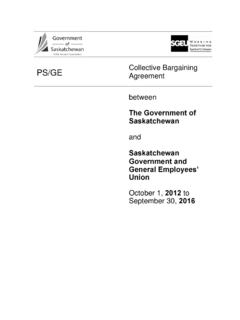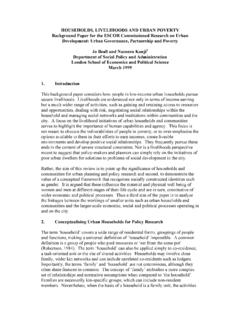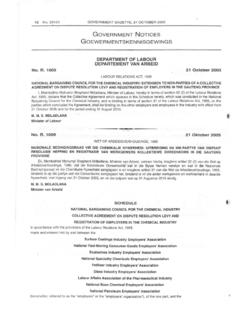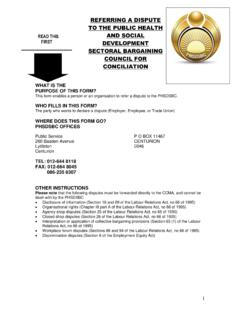Transcription of “BARGAINING AND GENDER RELATIONS: W B H
1 1 BA R G A I N I N G A N D GE N D E RRE L A T I O N S : WI T H I N A N D BE Y O N D T H EHO U S E H O L DBina AgarwalInstitute of Economic Growth, University of DelhiA B S T R A C THighlighting the problems posed by a unitary conceptualization of the house-hold, a number of economists have in recent years proposed alternativemodels. These models, especially those embodying the bargaining approach,provide a useful framework for analyzing GENDER relations and throwing somelight on how GENDER asymmetries are constructed and contested. At the sametime, the models have paid inadequate or no attention to some critical aspectsof intra-household GENDER dynamics, such as: What factors (especially quali-tative ones) affect bargaining power? What is the role of social norms and socialperceptions in the bargaining process and how might these factors themselvesbe bargained over? Are women less motivated than men by self-interest andmight this affect bargaining outcomes?
2 Most discussions on bargaining also sa ylittle about GENDER relations beyond the household, and about the linksbetween extra-household and intra-household bargaining power. This paperspells out the nature of these complexities and their importance in determin-ing the outcomes of intra-household dynamics. It also extends the bargainingapproach beyond the household to the interlinked arenas of the market, thecommunity and the E Y W O R D SBargaining models, bargaining power, GENDER relations , householdeconomics, social norms, altruismI .I N T R O D U C T I O NThe nature of GENDER relations relations of power between women andmen is not easy to grasp in its full complexity. But these relations impingeon economic outcomes in multiple complexity arises not leastfrom the fact that GENDER relations (like all social relations ) embody boththe material and the ideological. They are revealed not only in the divisionof labor and resources between women and men, but also in ideas and rep-resentations the ascribing to women and men of different abilities, atti-tudes, desires, personality traits, behavior patterns, and so on.
3 GenderFeminist Economics3(1), 1997, 1 511354 5701 IAFFE 1997relations are both constituted by and help constitute these practices andideologies, in interaction with other structures of social hierarchy such asclass, caste and race. Neither uniform across societies nor historically static(as numerous studies of different cultures, regions and communities bearout), they may be seen as largely sociallyconstructed (rather than biologi-cally determined).2 The process of this social construction, however, isinadequately understood, as also how particular forms of GENDER inequali-ties are maintained, and by what means they might change over growing interest among economists in intra-household dynamicsimpinges on these questions. For instance, there has been an increasing criti-cism of unitary household models which assume that household membersseek to maximize utility on the basis of a set of common preferences repre-sented by an aggregate utility function, and a common budget constraint.
4 Arange of alternative household models use the game-theoretic approach toincorporate a more complex understanding of how family decision-makingoccurs, variously allowing for individual differences in preferences, in budgetconstraints and in control over resource use. Although most do not explicitlyaddress GENDER asymmetries they can accommodate such asymmetries, andthus provide a useful approach for analyzing GENDER relations and pointeconomic thinking in a new direction. At the same time, these formulations,consisting mostly of formal models, are restricted in their ability to incorpo-rate the full complexity of GENDER interactions within households, and thesimultaneity of various processes and forms of decision-making. In addition,most say little about GENDER relations beyond the paper outlines some aspects critical for understanding intra-house-hold dynamics from a GENDER perspective that existing household modelseither miss out altogether, or do not adequately address.
5 For instance, mostmodels characterize this dynamics as a form of bargaining , but typicallysay little about the complex range of factors, especially qualitative ones, thatmight determine bargaining power; what role social norms and perceptionsplay in the bargaining process; what effect GENDER differences (if such exist)in the exercise of self-interest might have on bargaining ; and so on. Suchfactors can impinge crucially on the accuracy of theoretical formulations,empirical predictions and policy interventions, and must therefore be givencognizance in framing hypotheses, data gathering and , models and policies could go awry if intra-household dynamicsare assumed (as they often are) to exist in isolation, without examining theextra-household socio-economic and legal institutions within which house-holds are embedded, and how these institutions might themselves besubject to change. The paper seeks to provide pointers on this count as well,extending the bargaining approach beyond the household to the inter-linked arenas of the market, the community and the this purpose, I both use and emphasize the usefulness of what I term analytical description for capturing the complexity and historic variabilityA R T I C L E S2of GENDER relations in intra- and extra-household dynamics.
6 By analyticaldescription I mean a formulation that seeks to comprehensively spell outboth qualitative and quantitative factors that might impinge on outcomes,without being preconstrained by the structure that formal modelingimposes, or by data limitations. A formal model could be seen as a subsetof analytical description; and empirical analysis based on the model as afurther subset. All three analytical description, a formal model andempirical analysis can in different ways extend our understanding abouthow GENDER relations get constructed and contested within and outside I .B A R G A I N I N G A N D I N T R A - H O U S E H O L DG E N D E R R E L A T I O N SAre you suggesting that women should be given rights in land? Whatdo women want? To break up the family?(Minister of Agriculture to the author at an Indian PlanningCommission seminar on Land Reform, June 1989)Whether or not so intended, the Minister s reaction implies at least twoassumptions about the family: that its stability as an institution hinges onthe maintenance of unequal resource positions between women and men;and that economic self-interest plays an important role in intra-familygender relations , which would be revealed with particular starkness ingender con ict over a critical form of property such as arable land.
7 Such apicture of the family is a far cry from that implicit in much of standard econ-omic theory, namely of the family as an undifferentiated unit governed pri-marily or solely by latter picture is today dif cult to defend in the face of growing evi-dence to the (I will use the two terms inter-changeably4) are recognizably constituted of multiple actors, with varying(often con icting) preferences and interests, and differential abilities topursue and realize those interests. They are arenas of (albeit not the soledeterminants of ) consumption, production and investment, within whichboth labor and resource allocation decisions are made. And evidence frommany regions reveals persistent GENDER inequalities in the distribution ofhousehold resources and number of economists are today grappling with such complexities,within and outside the game-theoretic format. Most take as their startingpoint a critique of Gary Becker s (1965, 1981) unitary model of the family,5agreeing that it is problematic.
8 This model treats the household as a singleentity in relation to both consumption and production. It assumes that allhousehold resources and incomes are pooled, and that resources are allo-cated by an altruistic household head who represents the household s tastes B A R G A I N I N G A N D G E N D E R R E L A T I O N S3and preferences and seeks to maximize household utility. There is lessagreement, however, on alternative approaches to intra-household inter-actions. These approaches cover a diverse range: cooperative, noncooper-ative, collective, or some mix of these. In varying degrees they seek toincorporate the social reality of the family as described in anthropologicaland sociological writings. Differences between the approaches, outlined inseveral excellent review articles, do not need detailed repetition ce it to mention their broad features. Barring the collective models 7which make no assumption other than that the outcome will be Paretoef cient (and which attempt to uncover the decision-making rules and pro-cesses through empirical analysis), all the others characterize householddecision-making as some form of bargaining .
9 A brief outline of the bar-gaining framework is therefore the bargaining approach, intra-household interaction is charac-terized as containing elements of both cooperation and con ict. House-hold members cooperate insofar as cooperative arrangements make eachof them better-off than noncooperation. However, many different coopera-tive outcomes are possible in relation to who does what, who gets whatgoods and services, and how each member is treated. These outcomes arebene cial to the negotiating parties relative to noncooperation. But amongthe set of cooperative outcomes, some are more favorable to each partythan others that is, one person s gain is another person s loss hence th eunderlying con ict between those cooperating. Which outcome willemerge depends on the relative bargaining power of the member s bargaining power would be de ned by a range of factors, inparticular the strength of the person s fall-back position (the outsideoptions which determine how well-off she/he would be if cooperationfailed), also termed as the threat point.
10 An improvement in the person sfall-back position (better outside options) would lead to an improvementin the deal the person gets within the early formal critiques of the unitary model used a cooperative bar-gaining approach, and relaxed only the assumption of common prefer-ences while retaining that of income pooling (Marilyn Manser and MurrayBrown 1980; Marjorie McElroy and Mary Jean Horney 1981), adapting to atwo-person household John Nash s (1950, 1953) formulation of coopera-tive bargaining problems within game theory. Household membersbargain over the use of the pooled income, the outcome depending ontheir bargaining power, determined by their respective fall-back depend, in turn, on what McElroy (1990) terms extra-householdenvironmental parameters (EEPs) such as parental wealth, a person snonwage income, and the legal structure governing marriage and cooperative models assume the attainment of Pareto optimality inhousehold decisions, enforceable and binding contracts, and symmetricalA R T I C L E S4positions between the parties in relation to information availability and bar-gaining ability, and say little about the actual process of contrast, the noncooperative models relax many of these assump-tions, including those of Pareto ef ciency, income pooling, and enforce-able and binding contracts.








